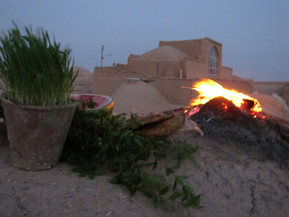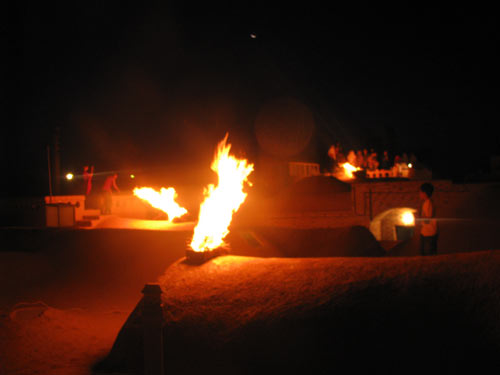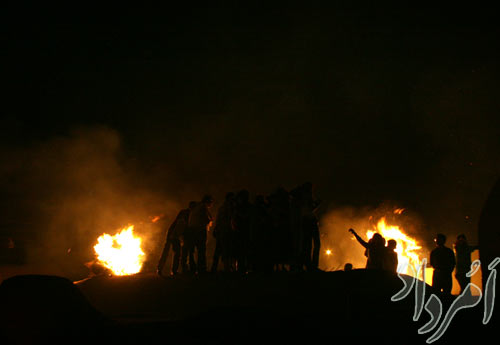| نوشته شده توسط پریسا خسروی : |
| یکشنبه, 04 تیر 1391 ساعت 21:05 |
|
برداشت از سايت مزرعه کلانترwww.mazrakalantar.com پنجي مزرا يعني همان جشنهاي باستاني در پنج روزهنگامي كه كوير و آتش و بوم با گذشته پيوند مي خورند، جشن پنجي برپا مي شود. پنجي مزرا، مزرعه كلانتر، يكي از روستاهاي زرتشتي نشين كه ويژگي هايش منحصربه فرد است.
Do you know what Panji is truly ? .Panji celebration in Mazra-e Kalantar is the same as the Panjeh celebrations in ancient Iran .When the desert of Yazd, the fire, and the house roofs unite, it is Panji. The Panji celebration in Mazra-e Kalantar, one of the Zoroastrian inhabited villages of Yazd, is unique .Five days before New Year there is a rush of work, and everybody is very busy. It is a very ancient New Year that has come down to us from generation to generation .In these five days, all are happy, and the atmosphere is full of joy. Not a single person has time to scratch her head, because a very important time is coming .Panji in Mazra means games, gahanbar, and merry making. Panji in Mazra has all the means to create joy and delight .Panji in Mazra means hot days and cool nights, sleeping on the roofs and waking up with the pleasant sound of Avesta, from the Darb Mehr loudspeaker You will see a little of many of the great celebrations of Iran, in these five days. The beginning of the new year is a reminiscent of our national Nowrooz, the fire on the roof recalls the fire of Sadeh, the happy ceremony of wetting each other with water recalls Tirgan. The Gahanbar in every house and the prayers gives a spiritual vibration to the participants, and the games are a sign of unity .Panji in Mazra means Nowrooz, and Sadeh, and Tirgan, and Gahanbar, and unity. It means joy and togetherness, something that our culture has put in our blood What is actually the Panji celebration? Panji is a familiar celebration for Zoroastrians. It is, according to the old chronicling, our famous Nowrooz. During the five days before New Year starts, everyone rejoices, and according to the old chronicling, this year, 29th Tir was New Yearís day. Of course, it is needless to say that those Zoroastrians who celebrate Panji do believe that Nowrooz is actually on the 1st of Farvardin (21st March), but just to commemorate the memory of our ancestors and the old chronicling, which our ancestors handed to us from generation to generation, they also celebrate the Panji You have to come and see it for yourself. Itís no use describing. In most of the villages of Yazd, where Zoroastrians live, this celebration is held. This year we visited Mazra-e Kalantar. It is a place that looks different, thanks to the efforts of the village governor, the Anjuman and its people. It has taken good shape and looks orderly. It is alive and well inhabited. It seems that the Panji celebration has brought a different atmosphere to it. From all over the world, and from all over Iran, Zoroastrians come to participate in this celebration. Especially those who belong to Mazra, and who stem from a Mazraie ancestor, make it a point to participate. Of course, those who do not at all belong to Mazra are also well received. This year the Panji celebrations started from 24 Tir, equivalent to 15 July, (every 4 years it goes one day backward because of absence of the leap year in this chronicling) and lasted for five days. On the morning of 29th Tir, equivalent to 20th July, the celebrations ended with the lighting of fire on all house roofs. In these five days a round of sports games were held. At the same time, Gahambar ceremonies were held in the houses. Because of the hot weather, children and young boys and girls played splashing water on each other. But the peak of the celebration was the fire lighting on the roofs on the New Yearís day (29th Tir), which is held on 1st Farvardin nationally. The lighting of fire is a culture that meant, in ancient days, to inform the public about the New Year , since the best way to spread such news in those days was by light and smoke. This has still stayed with us as a very beautiful ceremony, creating redundant joy and excitement among all. In later times nations used canons to announce celebrations. Now-a-days, media has taken over this job. But, Zoroastrians are still using the ancient system of lighting fire on New Year, as a way to preserve this beautiful culture .Some even believe that the Chahar-shanbeh Suri celebration (lighting fire on the last Wednesday of the year) has roots in this ancient ceremony .Though the Panji of Mazra is no more considered as New Yearís day, and some even criticize its celebration, but we know that it brings joy and unity to our community and this is good enough |



